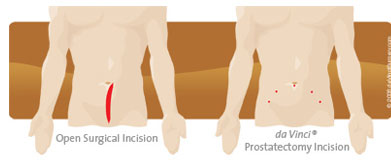Prostate Cancer
Robotic-Assisted Prostatectomy
Robotic-assisted prostatectomy video
Prostate cancer is the most common cancer in men. When it is localized to the prostate, patients have several curative options including a radical prostatectomy (complete prostate removal) or radiation treatments (including protons). Because each patient’s case is different, detailed discussions with a urologist and other cancer specialists will help clarify the risks and benefits of the various treatment options.
At UC Davis Health, when complete removal of the prostate is indicated, the majority of prostatectomies are conducted via the minimally invasive, da Vinci robotic-assisted surgical system.
Learn more by visiting our Robotic Prostatectomy Frequently Asked Questions page >>
Benefits to patients
- Reduced pain and trauma to the body
- Less blood loss and need for transfusions
- Less post-operative pain and discomfort
- Less risk of infection
- Shorter hospital stay
- Faster recovery and return to normal daily activities
- Less scarring
Robotic-assisted prostatectomy: Less invasive, faster recovery
The UC Davis surgical urology team includes highly experienced and trained surgeons, nurses and technicians who perform dozens of procedures each month. Our oncology specialists, Marc Dall'Era and Christopher Evans, have all trained with the da Vinci® robotic surgical system and are skilled at using it for prostatectomy cases.
 Robotic-assisted procedures allow surgeons to remove the prostate through small keyhole incisions using pencil-sized, precision-guided instruments. This minimally invasive technique is part of the urology department’s commitment to minimizing pain and length of convalescence, as well as improving outcomes such as erectile function and urinary control. During the operative procedure the surgeon sits at a controlling console near the patient while an assistant surgeon is at the bedside next to the patient. The surgeon watches the operative field through a video monitor and controls the robotic arms that replicate the surgeon's hand movements at the console. The cancerous prostate is removed using operative principles of radical prostatectomy that have been refined over several decades.
Robotic-assisted procedures allow surgeons to remove the prostate through small keyhole incisions using pencil-sized, precision-guided instruments. This minimally invasive technique is part of the urology department’s commitment to minimizing pain and length of convalescence, as well as improving outcomes such as erectile function and urinary control. During the operative procedure the surgeon sits at a controlling console near the patient while an assistant surgeon is at the bedside next to the patient. The surgeon watches the operative field through a video monitor and controls the robotic arms that replicate the surgeon's hand movements at the console. The cancerous prostate is removed using operative principles of radical prostatectomy that have been refined over several decades.
The da Vinci Surgical System has been used successfully in thousands of prostate cancer procedures around the world. Most patients are able to return to normal activity in two-to-three weeks instead of the six-to-eight weeks more common with standard "open" surgery. There is less blood loss during a robotic-assisted prostatectomy, resulting in a higher blood count. The higher blood count provides for quicker return of strength and stamina after surgery. Of course, as with any surgical procedure, these benefits cannot be guaranteed. Successful outcomes depend on both the patient and the procedure.
